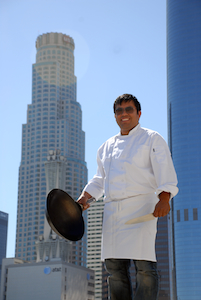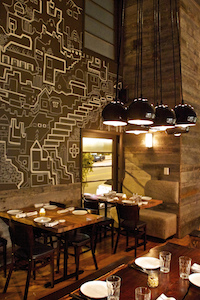Special Feature: Products Sally Recommends
ricardo zarate: peru's culinary ambassador to north america
by Andrea Rademan
 Wiping his brow, the chef made a mental note of his progress. The first two courses had already been served, the chicharon with scallops was nearly ready and, after he added the Peruvian chile aji limon to the octopus tiradite, he could finish the desserts. The 600 members of Lima’s business elite devouring this feast had no idea that the sixteen-year-old preparing it in his mother’s kitchen had never before been paid to cook. But that night Ricardo Zarate, whose dream of bringing Peruvian cuisine to the world was hatched before he was twelve, and launched in 2011 when Food and Wine Magazine named him Best New Chef in America, knew that he had found his future.
Wiping his brow, the chef made a mental note of his progress. The first two courses had already been served, the chicharon with scallops was nearly ready and, after he added the Peruvian chile aji limon to the octopus tiradite, he could finish the desserts. The 600 members of Lima’s business elite devouring this feast had no idea that the sixteen-year-old preparing it in his mother’s kitchen had never before been paid to cook. But that night Ricardo Zarate, whose dream of bringing Peruvian cuisine to the world was hatched before he was twelve, and launched in 2011 when Food and Wine Magazine named him Best New Chef in America, knew that he had found his future.
Until then, the most exciting accomplishments this eleventh of thirteen siblings had experienced were the nights it was his turn to prepare the family dinner. “I would write out the menu and hang it on the refrigerator door so everyone could admire it,” he says. “It made me feel like a real chef.”
Zarate had just finished a degree at culinary college when a Peruvian friend offered him his very first restaurant job, as a dishwasher at Benihana’s in London. “I’d never been out of Peru and I didn't know a single word of English so naturally I went,“ he says. “Most of the chefs had already been working there for about thirty years so they were glad to have this young kid help out and they kept me plenty busy.” But talent will tell and within six months the new dishwasher was elevated from the sink to the hibachi (grill).
“After two years of working and going to culinary school, I decided to go from one restaurant to another so I could learn as much as possible." As mentor Mark Gregory’s sous chef at One Aldwych Hotel’s Axis restaurant, he found inspiration and as executive chef at Zuma, a modern Japanese izakaya (pub), he found acclaim.
A life-changing offer brought him to the Biltmore Hotel in Los Angeles. “We were going to do a project there with Tetsuya Wakuda, a famous Australian Japanese chef, but that was called off after 9/11.” By that time Zarate felt at home in Los Angeles, with its considerable Latin and Asian influences. He took over the hotel’s Japanese restaurant, Sai Sai, and decided to stay. "When I see Los Angeles, I see Lima," he says.
By 2009 he was heading a tony sushi restaurant on the west side of this sprawling city. He scraped together enough money to open Mo-Chica, a food stall in the warehouse district’s Mercado La Paloma. At dawn he’d cross town to shop the wholesale markets, then he’d head to Mo-Chica, where he’d cook and serve traditional Peruvian dishes like aji de gallina (chicken stew), lomo saltado (marinated steak and potatoes) and ceviche. Around 2 p.m. he’d close up and drive back across town to his other full-time job, where he worked most nights until at least 1 a.m.
Mo-Chica was quietly developing a following when Jonathan Gold, Los Angeles’ Pulitzer-Prize winning restaurant critic, dropped in and anointed Zarate’s signature seafood dish “the city's definitive ceviche.” Suddenly, Mo-Chica was on virtually every “best of” restaurant list. When important visitors arrived from Japan, the consul general bundled them into his limousine and made the Peruvian eatery with a Japanese hostess in a kimono their first stop. When Mo-Chica made it into the Zagat Survey, reflecting both the chef’s genius and the humble setting, it earned a 25 out of 30 for food and a 7 for décor.
 In 2011, Zarate and business partner Stephane Bombet, a St. Tropez transplant, debuted Picca, their take on a Peruvian gastropub, in a converted townhouse. It’s noisy and fun, with small plates, giant graphics, and killer cocktails by bar master Julian Cox, whose award-winning pisco sours honor the national drink of Peru. Along with are a variety of anticucho (skewers), a snack that the chef once sold on the streets of Lima, there are various ceviche marinated in Zarate’s signature leche de tigre (tiger’s milk) a concoction of lime and onion with uni, rocoto and chile amarillo garnished with sweet potato and giant corn.
In 2011, Zarate and business partner Stephane Bombet, a St. Tropez transplant, debuted Picca, their take on a Peruvian gastropub, in a converted townhouse. It’s noisy and fun, with small plates, giant graphics, and killer cocktails by bar master Julian Cox, whose award-winning pisco sours honor the national drink of Peru. Along with are a variety of anticucho (skewers), a snack that the chef once sold on the streets of Lima, there are various ceviche marinated in Zarate’s signature leche de tigre (tiger’s milk) a concoction of lime and onion with uni, rocoto and chile amarillo garnished with sweet potato and giant corn.
Before the opening, the partners launched a series of pop-up dinners they called Test Kitchen, where they hosted some the city’s most renowned chefs as well as visiting celebrity chefs such as Tijuana’s Javier Plascencia, for a limited number of always-sold out evenings. For the chefs, it served as a chance to test new concepts or a place to cook between kitchens and, for Zarate, it was an opportunity to interact with them.
Last year, they moved Mo-Chica to a central downtown location with a glassed-in kitchen, chili-pepper-red walls where artist Kozem has spelled out the restaurant’s name in graffiti lettering, and a liquor license so customers can accompany the updated Peruvian comfort foods — Spanish mackerel in amarillo pepper sauce; Cau Cau (tripe stew); alpaca and lamb burger; and mushroom risotto made with quinoa standing in for rice — with drinks like Tha Doggfather, a Pisco sour, and the Oaxacalifornia Love, mezcal dosed with pineapple and rocoto peppers.
Paiche is on the menu at Mo-Chica and it’s also the name of Zarate’s newest venture, a sleek Peruvian izakaya named for this once endangered massive Amazonian fish that is now being farmed. It’s the sweet and tender star of the Peruvian-Japanese seafood show that is reviving a sleepy coastal neighborhood with jolts of chaufa de langosta (sizzling fried rice with lobster bits offset with pickled radish); shrimp with jalapeño ponzu wrapped in flaky phyllo dough; grilled fish ribs basted with lime miso; and custardy uni, drizzled with rocoto honey and served on toast. Eat it on the reed-lined patio with its volcanic rock fireplace and pair the dishes with cocteles clasicos y olvidados (classic and forgotten cocktails): caipirinha; mojitos; Cuba libres; side cars; margaritas; mint juleps; and cocktails starring, of course, mezcal and pisco.
When asked to define Peruvian food, Zarate responded, “I think it’s a completely new flavor. Peruvian cuisine is the result of hundreds of years of Spanish, European, and Japanese influences. People use the word “fusion” for my cooking, but Peruvian food is already fusion on its own. I just clean it up a little bit.“
![]()
Article first published in thelatinkitchen.com.
Note: This information was accurate when it was published. Please be sure to confirm all rates and details directly with the businesses in question before making your plans.



